HTIRC E-NEWSLETTER – December 2015
Volume 8 Issue 2
Articles in this issue:
- Dr. Douglass Jacobs Has Been Appointed Co-Director of HTIRC
- HTIRC Hosts Advisory Committee Meeting
- USDA Forest Service Conducts 10 Year Review of the HTIRC
- Awards, Grants, and Announcements
- Purdue Alumnus Launches Startup for Genetically Improved Hardwoods Sales, Consulting
- Welcome Dr. Carrie Pike!
- Propagating Figured Black Walnut – Can it be Done?
- Presentations from the HTIRC Advisory Committee Meeting
Welcome to this issue of the Hardwood Tree Improvement and Regeneration Center E-newsletter. The HTIRC is committed to enhancing the productivity and quality of Central Hardwood Region trees and forests for the economic and environmental benefits they provide. Scientists at the HTIRC are using conventional tree improvement breeding as well as molecular and genetic technologies to improve the wood quality, growth characteristics, and insect and disease resistance of trees like black walnut, black cherry, red and white oaks, butternut and American chestnut. Research in tissue culture, tree nursery practices, tree plantation establishment and management, and Central Hardwoods silvicultural systems is aimed at increasing the regeneration success rate for high quality hardwood trees and forests. Some interesting and unusual research areas include examining the potential for propagating trees with “figured” wood: birds-eye maple or curly walnut; and breeding trees that will be an economical source of bio-fuels. Twice per year we will attempt to provide interesting and useful information on Central Hardwood trees and forests, as well as sources for additional information and assistance. Please pass this newsletter along to others who may enjoy or benefit from the information provided. If you would like a closer look at the HTIRC, please visit our web site at: http://www.htirc.org
Dr. Douglass Jacobs Has Been Appointed Co-Director of HTIRC

As the HTIRC program has grown, so has the recognition that joint leadership from Purdue University and the USDA Forest Service Northern Research Station offers the best hope for building on the Charles Michler legacy. Dr. Douglass Jacobs, Fred M. van Eck Professor of Forest Biology at Purdue, has agreed to serve as Co-director. Doug will join Manfred Mielke as Co-director. Manfred has served as Acting Project Leader for the HTIRC research work unit of the NRS since April 13th. Working together, we are confident that Doug and Manfred will strengthen HTIRC in terms of its research and relevance. In Doug’s new role, he will provide oversight for leadership of Tropical HTIRC, serve as Purdue’s Site Director for National Science Foundation Industry and University Cooperative Research Center for Advanced Forestry Systems grant, coordinate with the Purdue Research Foundation on issues of intellectual property and licensing, and administer the Fred M. van Eck Scholarship program on behalf of the Department of Forestry and Natural Resources at Purdue.
HTIRC Hosts Advisory Committee Meeting
The HTIRC hosted a conference on October 27, 2015 for advisory committee members, partners, and friends to highlight research efforts. Forest Service researchers and Purdue faculty and students working in the HTIRC provided both presentations and field tours at the Purdue University Department of Forestry and Natural Resources John S. Wright Forestry Center and Martell Forest near West Lafayette, Indiana.
Following the presentations and field tour, Co-Director Manfred Mielke facilitated a session where attendees were afforded an opportunity to provide input and comments on the current research work and future directions for HTIRC. The feedback from this session will help inform how HTIRC pursues our work in the future.
Presentations from the program are included in this newsletter. If you would like to see a more complete picture of the HTIRC, visit our website at www.htirc.org
USDA Forest Service Conducts 10 Year Review of HTIRC
The HTIRC is a partnership between the USDA Forest Service, Purdue University, and many other partnering organizations and individuals. A list of our partners is available on our website at www.htirc.org . In October of 2015, the USDA Forest Service conducted a 10 year review of the HTIRC program and the research and outreach work performed by Forest Service staff in the center. The purpose of this review is to examine the current direction of work, adjust efforts to meet future needs, and plan for personnel and resources required in the future to continue to meet the HTIRC mission to advance the science of hardwood tree improvement, genomics, physiology, protection, and utilization in the hardwood region of the United States.
Awards, Grants, and Announcements
Lawson Receives Abraham Lincoln Honor Award at the President’s Volunteer Service Ceremony:
Dr. Shaneka Lawson, Adjunct Assistant Professor of Forestry and Natural Resources and a Research Plant Physiologist with the USDA Forest Service – HTIRC, received a Silver President’s Volunteer Service Award from Secretary of Agriculture Tom Vilsack and Assistant Secretary of Agriculture Gregory Parham on November 5th at the USDA’s Abraham Lincoln Honor Awards Ceremony in Washington, D.C.
To qualify for a Silver Award, an employee must complete between 250 and 499 hours of volunteer service over a consecutive 12-month period. Dr. Lawson completed 401 volunteer hours. She was recognized for her tireless pursuit of diversity and inclusion initiatives, the writing and implementation of several Civil Rights grants that provided elementary school children with a summer forestry program, providing basic necessities for disabled veterans and mentally ill homeless persons staying in a shelter, and designing a program that taught middle and high school students about sustainability and environmental responsibility.
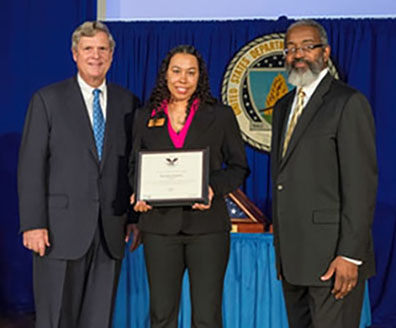
Lenny Farlee, Extension Forester with the HTIRC, was recently recognized as the Indiana Project Learning Tree Facilitator of the Year. Lenny received this award based on his work partnering with the Indiana DNR Division of Forestry Project Learning Tree program to provide a week-long forest management, research, and products workshop experience, the Natural Resources Teacher Institute, for classroom teachers and other educators.
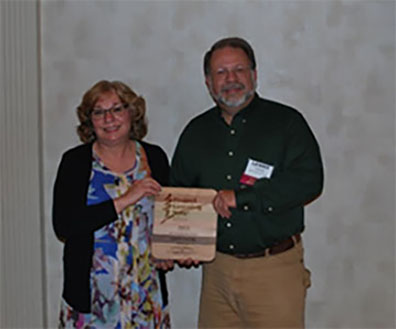
HTIRC graduate student Nick LaBonte, working with Dr. Keith Woeste, was just awarded an $8,000 grant from the American Chestnut Foundation to continue his research sequencing the genome of Chinese chestnut to identify regions associated with blight resistance. This research is part of his Ph.D. program. Earlier this year he was also awarded a grant from the Indiana Academy of Sciences to sequence the genome of the Indiana State Champion American chestnut in order to understand how American chestnut and Chinese chestnut differ at the DNA level.
The Manton Foundation has announced that it will support breeding and restoration of American elm by awarding a team of USDA Forest Service researchers from the Northern Research Station in Delaware Ohio and HTIRC $906,000 over the next five years. In collaboration with The Nature Conservancy, the grant will fund research designed to clarify the genetic basis for resistance to Dutch elm disease and to breed elms with increased resistance for use in urban landscapes and in watershed restoration.
HTIRC recently received donations from Mayfield Lumber Company for ash/emerald ash borer research ($3000), and Pike Lumber Company for thousand cankers disease research ($5000). We are grateful for this generous support from our wood products industry partners and supporters.
Some additional announcements of support for researchers in the HTIRC include:
Dr. Douglass Jacobs and Dr. Nathanael Lichti; USDA NIFA; $149,983; “Prediction and management of American chestnut (Castanea dentata) stand dynamics with natural regeneration and blight-induced mortality”
Dr. Douglass Jacobs; USDA Forest Service; $10,961; “Integrated spatial processes and tree seed dispersal and insect population dynamics within LANDIS-II” and USDA/Forest Service: $25,000; “Optimizing nursery photoperiod to promote root growth of forest tree seedlings after planting”
Dr. Michael Jenkins; USDA Forest Service; $15,000; “Evaluation of site conditions and management techniques to promote oak species regeneration in hardwood forests”
Dr. Michael Saunders; USDA Forest Service; $44,000; “Effects of prescribed fire within shelterwood regeneration systems on residual overstory timber quality”
Dr. Paula Pijut’s ash-emerald ash borer research was cited in an Ensia article titled, “In the race to save species, GMOs are coming to nature. Big question: Can we use genetic engineering to save species? Bigger question: Should we?” http://ensia.com/features/in-the-race-to-save-species-gmos-are-coming-to-nature/ . Ensia is a magazine showcasing environmental solutions in action. Their mission is to share stories and spark conversations that motivate, empower, and inspire people to create a more sustainable future.
Purdue Alumnus Launches Startup for Genetically Improved Hardwoods Sales, Consulting
Landowners who are interested in planting high quality hardwood trees could benefit from a startup launched by an alumnus of the Purdue University Department of Forestry and Natural Resources. Aaron Forgey, who earned his degree in forestry and natural resources in 2014, is the owner of Legacy Hardwoods LLC. The company will be selling trees, including black walnut and black cherry, which have been bred and screened to determine they have potential to produce higher quality trees for wood production than unselected seedlings. These trees are a product of the breeding program in the HTIRC. Along with producing and selling trees, Forgey consults landowners to ensure they take the proper steps to maximize their investment.
Welcome Dr. Carrie Pike!
Dr. Carolyn “Carrie” Pike has accepted a position as regeneration specialist for the US Forest Service Northeastern Area’s Forest Management Program. She has extensive experience with tree breeding, conducting applied research, and with establishing and analyzing common garden studies. Her primary duties will be delivering technical assistance to State nurseries in the Northeast and Midwest, and providing advice on genetics and restoration programs nationwide through the Reforestation, Nurseries, and Genetic Resources program. Carrie is based at Purdue University and the HTIRC is very pleased to have opportunities to collaborate with her. Her full position announcement can be viewed here.

Propagating Figured Black Walnut – Can it be Done?
By James R. McKenna, USDA Forest Service, Wayne A. Geyer, University of Kansas, Keith E. Woeste, USDA Forest Service, Daniel L. Cassens, Purdue University
Figured wood from hardwood trees, depending on appearance and consistency, can attract impressive values for specialty veneer, furniture, or even musical instrument construction. Flame, curly, quilted, and birdseye are a few of the figure patterns that may occur in a variety of hardwood trees. Figured grain patterns occurring in walnut include “fiddle-back” or “curly” grain, depending on the number of horizontal lines visible in the grain of the finished wood. Black walnut has historically been the most valuable timber tree from the central hardwood region of the United States for non-figured wood, and trees that have consistent figured patterns throughout the log may be of even greater value.
The occurrence of figured walnut in nature is rare and unpredictable. This has led to interest in propagating trees from parent trees with excellent figure. The crucial question is, will propagated trees have the same desirable characteristics as the original? A complicating factor is the intensity and distribution of figure controls the potential value in the market. Very light figure or figure that is not evenly distributed in a log may be regarded as a defect or undesirable, as compared to strong figure distributed evenly throughout the log. Figure in the tree to be propagated must be reproduced true-to-form from rooted cuttings or grafts if clonal propagation is used. If tree breeding is used to reproduce the plants, the figure must be related to a trait that is genetic and heritable, allowing transfer from parents to offspring. The propagation of figured black walnut has been hinted at in the past, but well-documented, consistent results are lacking.
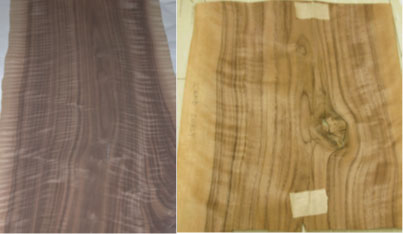
Figure 1. Examples of figured grain types in black walnut. A fiddleback sample from a wild tree in Iowa exemplifies the type of commercially valuable figured grain black walnut clones have been selected for and that are desired to reproduce (left). A curly sample from a relatively young grafted ‘Lamb’ tree from Kentucky (right).
In a cooperative study involving James McKenna and Keith Woeste from the HTIRC, Wayne Geyer from Kansas State University, and Dan Cassens from Purdue University, logs from grafted trees derived from several highly figured wild trees and seedling walnuts that are the product of open pollinated seedlings from grafted parent trees with commercially valuable figure, were evaluated for the presence of figured wood. To evaluate walnut offspring of these figured trees for figured grain, seedlings need to be grown for several decades to allow their figured grain to express, and trees must be harvested so stem segments can be split to evaluate grain patterns. If heritability is low, another round of breeding and selection would be required to increase the percentage of figured seedlings and to reduce variation among seedlings. Environmental and cultural factors that affect expression of figured grain also need to be determined and accommodated if breeding is to succeed.
In the early 20th century, George Lamb, a veneer buyer of figured walnut and mahogany, found a highly figured curly walnut harvested in January 1926 near the town of Ada, Michigan. Lamb obtained scion wood, and distributed it to nurserymen and members of the Northern Nut Growers Association (NNGA) to graft and preserve, and suggested that figured walnut could be propagated asexually through grafts or sexually from seed. Lamb stated that the veneer from this tree was valued at $9094 in 1926 US dollars, which would be about $100,000 today. Soon after, the tree became known as “Lamb’s Curly”. The staggering value of this tree, and George Lamb’s association with NNGA members eager to grow valuable figured walnut wood, began the research that continues today.
Since the discovery of the curly “Lamb” walnut, tree improvement specialists around the Central Hardwood region of the US have collected and grown trees from scion wood originating from other highly figured walnut trees. In the 1970s, Dr. Loy Shreve of the Kansas Forest Service obtained scion wood from eight highly figured walnut trees. More recently, the Hardwood Tree Improvement and Regeneration Center (HTIRC) of the USDA Forest Service, Northern Research Station, established clone banks (plantations that preserve genetic lines or families) and seed orchards of these and 16 other figured walnut clones as part of a breeding program aimed to develop, improve, and regionally adapt fine hardwood planting stock for the Central Hardwood region. The research project presents the results from milling logs of three grafted figured walnut clones planted more than 30 years ago in a seed orchard in Kansas to determine if figured grain can be propagated true-to-type through grafting. We also examine 10-year-old open-pollinated “Lamb” seedlings that were grown in a black walnut plantation in Indiana for figured grain.
To ensure that the correct clones were sampled, DNA genotypes were determined. Leaves were collected in 2005 from the Kansas and Indiana orchards, and DNA was extracted to verify genotypes. Cross-sections of each log were collected at the time of harvest, dried and sanded, and growth rings were counted to age each tree and determine the percentage of heartwood and sapwood. Logs were milled into four-quarter lumber on a portable sawmill, stacked, and air-dried for two months, then surface-planed, and boards were visually inspected for figured grain. Ten half-sibling (same mother tree but unknown father) open-pollinated seedlings from a grafted “Lamb” walnut were harvested after 10 years of growth in a black walnut progeny test at the Lugar Farm, Purdue University, West Lafayette, Indiana in 2010. The basal 18 inches of each trunk was split with a hatchet (split-test) to determine the presence or absence of figured wood.
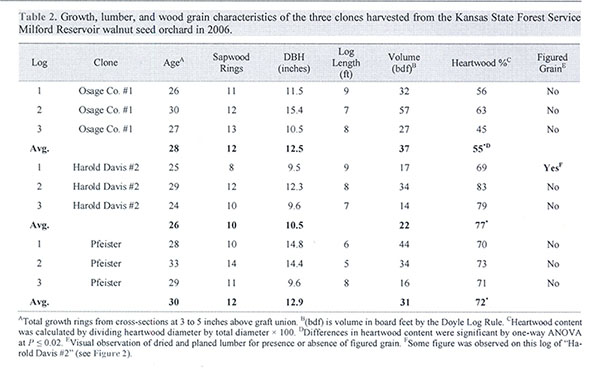
One tree, a Harold Davis #2 clone, did have some figured wood, but the figure was not distributed throughout the section of wood sampled. This small amount of figure is unlikely to represent any wood value premium, and may actually depress value since the figure is not consistent across the board.
How often commercially valuable figured grain occurs in natural stands of walnut is difficult to estimate. Discussions with wood products representatives indicate that only 1/500 to 1/1000 walnut trees may exhibit valuable figure. The fact that we observed some figure in one of nine logs may indicate a real genetic component for figure in walnut, but the expressivity and penetrance of the trait is low. The little figure expressed in our study suggests that environmental (Genetic × Environment) factors, which we do not yet understand, are critical for figure to develop consistently throughout a walnut log.
Prior to the present study, we harvested and milled two grafted “Lamb” trees in Indiana (data not shown). One tree had no figured grain at all, and the other tree had a little figure in a portion of the bole much like the “Harold Davis#2” log in Figure 2. The veneer sample from a grafted “Lamb” in Figure 1 shows curly figure, but the commercial value of this sample is questionable. Decades ago, a sample with better curly figure from a single grafted 12-year-old “Lamb” tree was brought to the NNGA annual meeting and photographed. These few examples and the figure we observed in the present study are the only documented cases of figured walnut having been propagated by grafting.
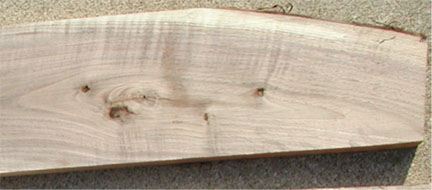
Figure 2. Close-up of the figure found in one log of “Harold Davis #2”.
One explanation for the low expression of figure in grafted trees could have to do with alterations in the physiology of grafted trees. The root system from the parent stock may be important in the hormone balance responsible for figured grain formation in the stem. The plant hormone auxin, synthesized in shoot tips, affects the orientation of microfibrils of cell walls and cell expansion. Cytokinin, a second plant hormone involved in cell division and differentiation, is synthesized in root tips and travels upward to the shoot system. Changes in the ratio of auxin and cytokinin can affect plant development processes. A distinct auxin and cytokinin ratio could be necessary for figure to develop, and grafting could disrupt that ratio and lower the expression of figured wood development.
Breeding seedlings may avoid physiological differences between root and shoot systems and produce more widely available planting stock; however, the type of genes and genetic mechanism of figure in walnut remains to be determined. Unlike grafted walnut, seedlings have not been reported to produce figure. Walnut tends to outcross at least 90% of the time, and although selfed (self-pollinated) progeny occur and grow, they have been found to suffer slower growth and reduced survival. Some research indicates figured trees often have slow growth and reduced vigor; thus, figure in walnut may be controlled by recessive genes. Our results with open-pollinated seedlings support this hypothesis. Indeed, if the genes for figure in walnut are recessive, only selfed families and figured x figured crosses would be expected to show figured grain.
In this study, evaluation of lumber from three grafted figured walnut clones grown for nearly 30 years in a seed orchard did not propagate commercially valuable figured grain; only one of nine logs showed a small amount of figure. The fact that some figured grain was expressed indicates that the trait may have some genetic component in walnut, but the genetic mechanism is not known. Plantings of seedlings from isolated seed orchards containing these figured clones and others have been established in Indiana to investigate the role that root systems, figured × figured crosses, and selfing have on figured grain expression. In the meantime, landowners, foresters, and nurseries are cautioned that figured black walnut planting stock has not been demonstrated to propagate commercially valuable figured walnut lumber.
The USDA-Forest Service Northern Research Station and the Kansas State Forest Service and the Department of Forestry & Natural resources at Purdue University provided staff and support to conduct this study.
This article is derived from the publication Propagating Figured Wood in Black Walnut published in the Open Journal of Forestry, 2015 vol. 5, pages 518-525.
You may view the entire publication at: https://www.purdue.edu/htirc/pdf/publications/Propagating%20Figured%20Walnut%20Wood%20-%202015.pdf
Presentations from the HTIRC Advisory Committee Meeting
Integration of Molecular Biotechnologies for Developing Insect Resistance and Flowering Control in Black Ash – Jun Hyung Lee and Paula M. Pijut
Current Research in Ginzel Lab – Matt Ginzel, Tyler Stewart, and Bridget Blood
HTIRC Tree Improvement Accomplishments Over the Last Five-Years 2011-2015 – Jim McKenna
Hardwood Forest Regeneration and Restoration Silviculture – Douglass F. Jacobs
Restoration and Regeneration of Acacia koa in Hawaii – Kyle Earnshaw
The Use of Molecular Genetic Tools to Improve Hardwoods – Keith Woeste and Nicholas LaBonte
Have questions about tree planting? This series of publications can be viewed or downloaded free of charge. Planting and Care of Fine Hardwood Seedlings
van Eck Scholarships available for graduate research with the HTIRC.
Ask the HTIRC: email Lenny Farlee with your tree planting and forest management questions and we’ll help you find the answers.
